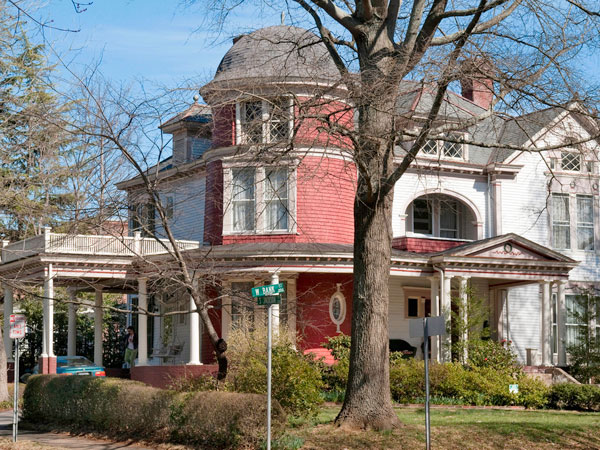Downtown Salisbury: Salisbury, North Carolina

Summary
Salisbury's picture-perfect historic downtown has done well by its community and master plans produced during the past three decades. Among the results: $117 million in investments, a thousand new jobs, nearly 300 restored or renovated buildings, and numerous awards. Achieving these outcomes has involved unwavering community pride, major gifts by several local philanthropists, and sustained efforts by city officials, downtown businesses, and volunteers who organized the Historic Salisbury Foundation in 1972. The group would go on to buy, restore, and sell more than 100 properties, including three local landmark buildings it still owns.
Designated Area
Neighborhood designation bounded by Caldwell and Fulton Streets to the north; Innes and Kerr Streets to the east; Lee, Main, and Church Streets to the south; and McCubbins Street to the west.

Community leaders attending a historic marker dedication in Historic Downtown Salisbury. Photo courtesy Lynn Raker.
Planning Excellence
Also instrumental was Salisbury's involvement, beginning in 1980, with the National Main Street program designed to help small towns and cities improve economically. That same year the nonprofit redevelopment corporation Downtown Salisbury, Inc., was formed to help promote the central business district.
Despite declines in the textile industry between the 1980s and early 2000s, downtown Salisbury's resolve to maintain its historic character attracted a steady rate of compatible development and restorations that didn't ebb until the 2008 recession. Still, retail and office space occupancy rates average 90 percent, making the neighborhood and its mixture of housing, shops, restaurants, museums, performing arts theaters, and other amenities a unique and vibrant place to work, live, or visit.

Students working on a pocket park in the Historic Downtown Salisbury neighborhood, where $117 million has been invested since 1980. Photo courtesy Sean Meyers.
Defining Characteristics, Features
History
- Salisbury established as seat of Rowan County (1755); textiles, distillation, and tobacco primary industries; attract German, Irish, Welsh, English immigrants
- Daniel Boone starts wilderness journey here (1769); George Washington stays in Salisbury during Southern Tour (1791)
- Transportation improvements during 1840s facilitate Salisbury as trade center; rail service (1855) expands city into government, judicial, commercial activities
- Main and Innes Streets divide town into four quadrants
Planning
- City launches Municipal Service District Facade Incentive Grants in early 1980s to encourage property owners to restore store and building fronts
- 2010 Downtown Master Plan envisions more residential housing in downtown, which now has more than 140 residential units
- Design guidelines in place since 1980s to help protect original character of neighborhood; 2011 Historic Preservation Master Plan goals include making it easier for people to own historic homes, make energy efficiency improvements
- Neighborhood's History and Art Trail has 19 interpretive sidewalk makers; public art displays; annual Discover What's Outside Sculpture Show
- Downtown business owners pay extra 16 cents per $100 property valuation for added services, facade restorations, low-interest loans
Architecture
- Rich heritage of historic architecture from 18th, 19th, and 20th centuries including Victorian, Antebellum, Greek, Gothic, Industrial, Modern, bungalow styles; most buildings two-three stories; tallest seven stories (The Plaza Building, 1912)
- Pre–Civil War buildings include the Archibald Henderson Law Office (Church and Fisher Streets, built between 1796 and 1818); St. Luke's Episcopal Church (Gothic Revival, 1828)
- Salisbury Historic District added to National Register of Historic Places 1975; district boundaries expanded in 1988, 1989, 2000
- Historic Salisbury Foundation's annual October Tour showcases different homes; funds used for restorations; 288 buildings refurbished since 1980

The Queen Anne-style McKenzie Grimes House on West Bank Street in Historic Downtown Salisbury. Flickr photo by Lumierefl (CC BY-NC-ND 2.0)
Physical Attributes and Amenities
- Businesses, services close by; 75 shops, 15 restaurants or coffee shops, five museums, library, three performing arts theaters within walking distance
- Waterworks Visual Arts Center in downtown features more than 25 artists
- Neighborhood includes farmers market, organic food store, Salisbury Symphony, The Black Box Theater, Piedmont Players Theater; Railwalk Art and Technology District has 120,000 square feet for technology-based businesses
- Historic Salisbury Foundation owns three iconic local landmarks: Railroad Passenger Station (1907), Dr. Josephus Hall House (1820), Grimes Mill (1896)
- Successful public-private partnerships along Main Street: F&M Financial Center, the restored Trolley Barn, and Easy Street, a multi-purpose pedestrian and festival venue; Bell Tower Park, Robertson-Eastern Gateway Park, Oak Grove-Freedman's Cemetery Memorial
- Downtown's Fisher Street used for outdoor concerts, holiday events


